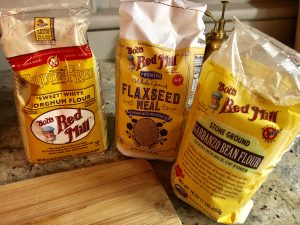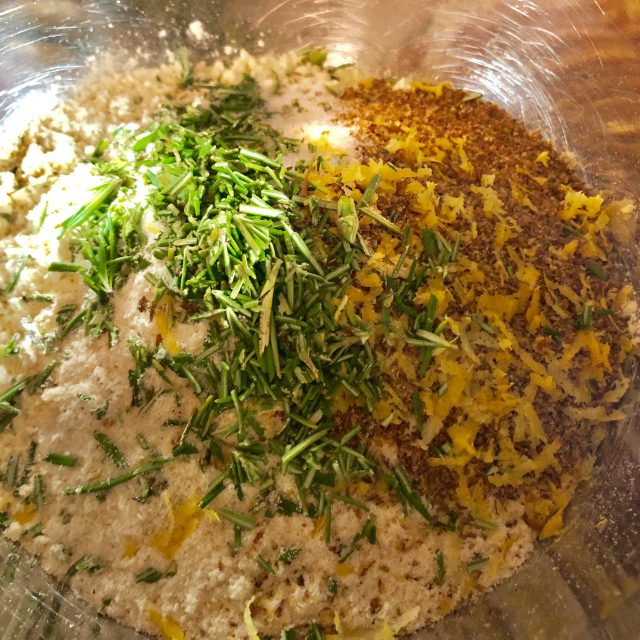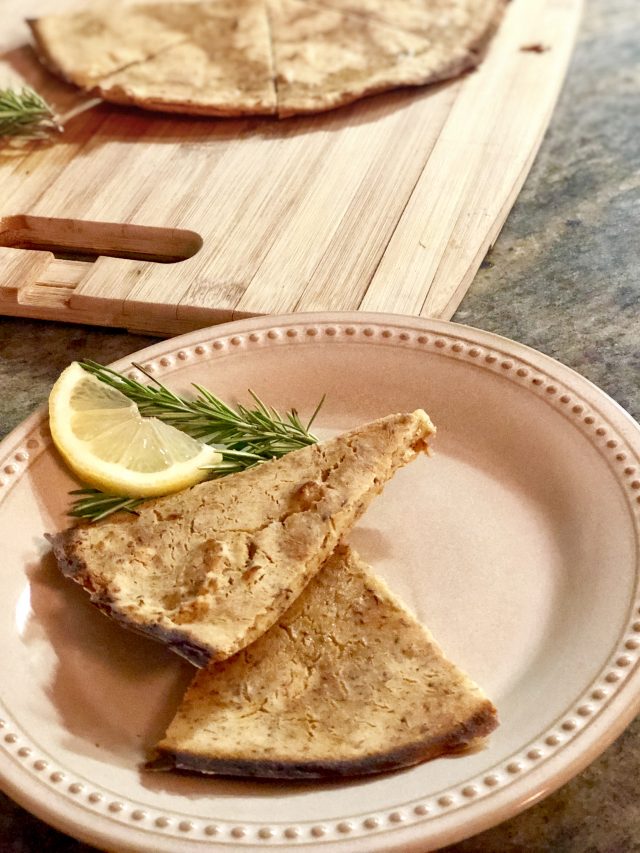This roasted garlic and rosemary flatbread is savory, fluffy, and nutritious – and naturally gluten-free, with only a few ingredients. The recipe uses a couple of less common types of flour – including sorghum and chickpea, which boost the health-benefits and flavor of the dish. This dish is also made almost entirely of cancer-protective foods: legumes (chickpea flour), whole grains (sorghum flour), flaxseed, and garlic.
I got the inspiration for this recipe from a popular pancake or crepe-like flatbread made by street vendors in the south of France called socca. Socca is traditionally made with 100% chickpea flour, which is mixed with water and olive oil and cooked in a pan in an open oven. It’s served cut into triangles and often eaten as an appetizer, sprinkled with salt and pepper.
 Chickpea flour (also called garbanzo flour) has a mildly earthy, rich flavor. The addition of sorghum flour to the batter provides a level of sweetness to balance the earthiness of the chickpea flour. Sorghum and chickpea flours are both fiber-rich, high in protein and a good source of other nutrients like iron. These flours can sometimes be more difficult to find, but most large groceries store or specialty markets will have them in the baking aisle.
Chickpea flour (also called garbanzo flour) has a mildly earthy, rich flavor. The addition of sorghum flour to the batter provides a level of sweetness to balance the earthiness of the chickpea flour. Sorghum and chickpea flours are both fiber-rich, high in protein and a good source of other nutrients like iron. These flours can sometimes be more difficult to find, but most large groceries store or specialty markets will have them in the baking aisle.
Sorghum is a cereal grain that originated in Africa but is now used all over the world and increasing in popularity. When ground into a flour it makes a great replacement for wheat. Ground flaxseeds round out this dish and provide heart-healthy omega-3 fatty acids (and eliminate the need for any other added fat in the batter).
The addition of roasted garlic and rosemary to this recipe are optional, but lend nice flavor to an otherwise simple dish. I like to roast an entire head of garlic to get the garlic soft and sweet tasting before adding it to the batter. Caramelized onions and other herbs like oregano would also be nice additions to the batter (or as toppings after the flatbread is cooked).
To start, preheat your oven to 450F. Slice the top off the head of garlic so the cloves are exposed and wrap the garlic in aluminum foil. Place the garlic in the oven to roast while you prepare the batter.
 When mixing the batter, you want it to be thick and smooth, but a few lumps are fine. It should be the consistency of pancake batter, so you can add more or less water if needed. A thinner batter will lead to a crispier flatbread. You can cook the batter immediately, but the flatbread will be lighter and fluffier the longer you let the batter sit. You can leave it for 30 minutes, or even up to several hours. Place your skillet in the oven to heat it up for at least 10 minutes before you are ready to cook the flatbread.
When mixing the batter, you want it to be thick and smooth, but a few lumps are fine. It should be the consistency of pancake batter, so you can add more or less water if needed. A thinner batter will lead to a crispier flatbread. You can cook the batter immediately, but the flatbread will be lighter and fluffier the longer you let the batter sit. You can leave it for 30 minutes, or even up to several hours. Place your skillet in the oven to heat it up for at least 10 minutes before you are ready to cook the flatbread.
When the garlic cloves feel soft when pressed, they are done roasting – about 30 minutes. Squeeze the cloves out of the husks and mix them into the batter.
This recipe makes enough for 2-3 flatbreads, so pour about ½ to 1/3 of the batter into your pan (about 1.5 cups). Pour less for a thinner/crispier crust; tilt the pan as needed to spread the batter evenly.
Broiling at the end helps brown and crisp up the top, but watch it carefully to make sure you don’t burn or overcook the flatbread.
 The flatbread should slide easily out of the pan so you can transfer it to a cutting board. Slice it into triangles and serve it hot on it’s own as an appetizer. It pairs well with olives, sliced tomatoes, and cheese. This flatbread also makes a great base for a pizza or as a replacement for toast in the morning topped with mashed avocado or an egg. I ate this with a little goat cheese and roasted asparagus for a quick and easy dinner.
The flatbread should slide easily out of the pan so you can transfer it to a cutting board. Slice it into triangles and serve it hot on it’s own as an appetizer. It pairs well with olives, sliced tomatoes, and cheese. This flatbread also makes a great base for a pizza or as a replacement for toast in the morning topped with mashed avocado or an egg. I ate this with a little goat cheese and roasted asparagus for a quick and easy dinner.
What would you serve with this savory, nutrient-rich flatbread?
Sonja Goedkoop, MSPH, RD, is Head of Food and Nutrition at Zesty, Inc. She is passionate about helping others improve their health through diet and physical activity and believes eating nutritious food should be easy and taste great. You can follow her on Twitter @SonjaGoedkoopRD.





